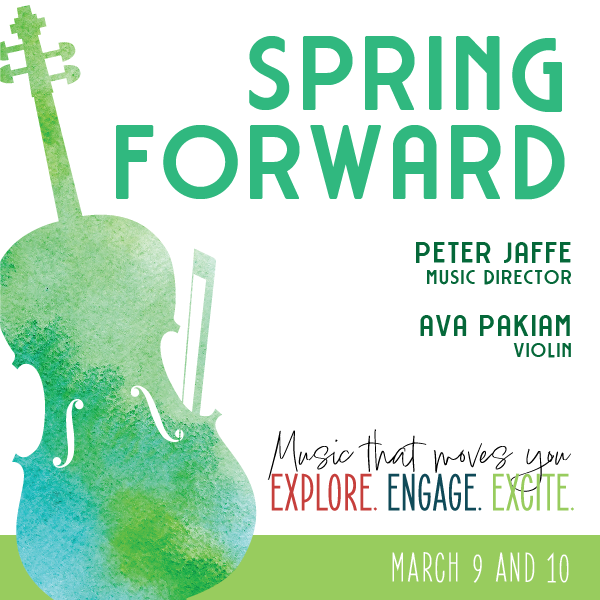
Concert sponsors: Drs. Thomas and Virginia Chen
Guest artist sponsors: Dan and Lynne Terry
Stockton Hematology Oncology Medical Group
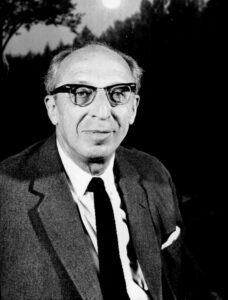
Aaron Copland composed one of his most popular, quintessentially American pieces in 1943–44 on commission from Elizabeth Sprague Coolidge for a ballet to be choreographed and danced by Martha Graham. He initially called his work simply “Ballet for Martha” until she chose the title Appalachian Spring after a poem by Hart Crane. The ballet, bearing no relation to the poem’s text, celebrates a young farm couple beginning their life together in the Pennsylvania hills in the early nineteenth century. Graham and her troupe first performed Appalachian Spring in its original version for a small chamber orchestra of thirteen instruments in the tiny Whittall Auditorium of the Library of Congress, Washington, DC, on October 30, 1944. Following their performance in New York the following May, the work received both the Pulitzer Prize for Music and the Music Critics Circle of New York award for the outstanding theatrical composition of the 1944–45 season.
Well-aware of its concert-hall potential, Copland arranged the ballet as a suite for large orchestra (1945), then made a large orchestra version of the complete ballet (1954), and was finally persuaded by new-music impresario Lawrence Morton to arrange the suite for the original thirteen instruments (1970), with permission for added strings. This last is the version presented here.
The Suite follows the order of the ballet’s scenario closely except for the omission of a section that Copland thought was of purely choreographic interest, which interrupts the famous variations on the Shaker hymn “Simple Gifts.” His signature music evoking wide open spaces provides a framework for contrasting sections of hesitation, tenderness, liveliness, harshness, and quiet strength. For the first performance of the Suite in 1945, Copland provided the following notes:
“The Suite arranged from the ballet contains the following sections, played without interruption:
’Tis the gift to be simple,
’Tis the gift to be free,
’Tis the gift to come down
Where we ought to be.
And when we find ourselves
In the place just right,
’Twill be in the valley
Of love and delight.
When true simplicity is gain’d,
To bow and to bend we shan’t be asham’d.
To turn, turn will be our delight,
’Til by turning, turning we come round right.
—©Jane Vial Jaffe
Scored for flute, clarinet, bassoon, piano, 2 first violins, 2 second violins, 2 violas, 2 cellos, bass, with added strings as authorized by the composer
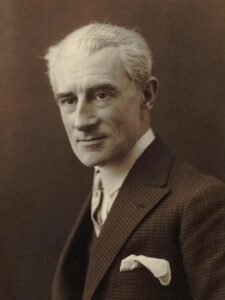
On one of his many performing tours to England, Ravel attended a private soiree in 1922 at which Hungarian violin virtuoso Jelly d’Arányi played the composer’s Duo with cellist Hans Kindler. As the evening progressed Ravel asked her to play a Gypsy melody, then another, until the party finally broke up at five o’clock in the morning. Though that occasion planted the seed for his Tzigane, rapsodie de concert (Gypsy, concert rhapsody), it took another two years for him to complete the piece because of numerous intervening projects such as the opera L’enfant et les sortilèges (The child and the sorceries)
As it turns out, Ravel completed the brilliant, challenging Tzigane just days before Arányi and pianist Henri Gil-Marchex were to premiere it on April 26, 1924, in London. Her sensational performance dazzled the audience and critics—all but one, who expressed confusion over whether the composer was parodying Hungarian Gypsy violin music or launching a new style with more warmth than his previous works had shown. On November 24 that year Arányi also premiered Ravel’s orchestrated version, this time in Paris with Gabriel Pierné conducting the Concerts Colonne orchestra.
While Ravel had been working on Tzigane he had sought technical advice from his violinist friend Hélène Jourdan-Morhange. “Come quickly,” he telegrammed her, “and bring the Paganini Caprices with you.” This speaks volumes about the kinds of feats expected of the violinist in this one-movement piece. The colorful but spare orchestral accompaniment prominently features the harp ingeniously combined with the solo violin.
The opening “cadenza” for the unaccompanied violin sounds improvisatory and declamatory, beginning, in the instrument’s sultry lowest range and progressing through slides, trills, octave passages, and harmonics, all the while calling for the kinds of changes and bending of tempo so characteristic of Gypsy music. Toward the end of the cadenza the accompaniment sneaks in quietly but with an unexpected harmony. The violin and orchestra together launch the dancelike main section of the piece, which varies ideas from the cadenza and introduces two new themes—a sprightly patter first given to the orchestra and a swaggering theme marked “grandiose.” Ravel creates an effect of humorous suspense by slamming on the brakes several times during his brilliant drive to the close.
—©Jane Vial Jaffe
Scored for 2 flutes, 2nd flute doubling piccolo, 2 oboes, 2 clarinets, 2 bassoons, 2 horns, trumpet, suspended cymbal, triangle, glockenspiel, harp, celesta, and strings
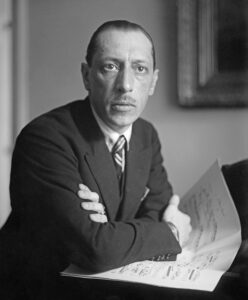
Ballet impresario Sergei Diaghilev approached Stravinsky in 1919 about writing a ballet that was entirely different from the dramatically innovative Firebird, Petrushka, and Rite of Spring. Having in mind the recent success of Vincenzo Tommasini’s ballet The Good-humored Ladies that was based on harpsichord sonatas by Domenico Scarlatti, Diaghilev asked Stravinsky to consider a number of works by another eighteenth-century Italian, Giovanni Battista Pergolesi (1710–1736). Stravinsky thought him mad but agreed to look at Diaghilev’s selections.
“I looked and I fell in love,” Stravinsky later recalled. These pieces—more than half of which have been discovered to be by composers other than Pergolesi—provided a turning point for Stravinsky. “Pulcinella was my discovery of the past, the epiphany through which the whole of my late works became possible. It was a backward look, of course—the first of many love affairs in that direction—but it was a look in the mirror, too.”
Diaghilev’s idea for the ballet called for the dancers to take on the roles of eighteenth-century commedia dell’arte characters. The story revolves around Pulcinella’s legendary immortality. He toys amorously with two Neapolitan girls and their suitors try to kill him. He feigns his death using his friend as “the body,” then, disguised as a magician, brings the fake Pulcinella back to life. In the happy ending he is reunited with his wife and the girls marry their suitors. Stravinsky arranged some twenty-one numbers to fit Diaghilev’s scenario and scored the work for an eighteenth-century–sized orchestra with solo (concertino) and ensemble (ripieno) parts—and three vocalists who sing from the pit.
Stravinsky retained most of the original melodies and bass lines from the “Pergolesi” selections, but provided more pungent harmonies, ostinato patterns, and slightly uneven phrase lengths. He also used the instruments in modern-sounding configurations and ranges. Alarming differences of opinion among Diaghilev, Picasso (scenery and costume designer), Massine (choreographer and lead dancer), and Stravinsky threatened the production, but the result, first performed at the Paris Opera House on May 15, 1920, was apparently satisfactory to all those involved.
Many critics found fault with Stravinsky’s new style—it was labeled as pastiche, too simple, and worst of all, a renunciation of his Russian heritage. Yet Pulcinella was an overwhelming popular success, and his Neoclassic style—perhaps better labeled neo-Baroque—exerted a profound influence on most composers of the 1920s and ’30s.
Like most worthwhile ballet music, Pulcinella also made its way in the concert hall, having been arranged in four versions, all differing in content: an orchestral suite of eleven movements (c. 1922); a suite of five movements entitled Suite for violin and piano, after themes, fragments, and pieces by Giambattista Pergolesi (1925) for violinist Paweł Kochański; the five-movement Suite italienne for cello and piano (1932), arranged with the help of cellist Gregor Piatigorsky; and the six-movement Suite italienne for violin and piano (1932) in collaboration with violinist Samuel Dushkin, for whom Stravinsky also wrote the Violin Concerto. The present orchestral suite was first performed by the Boston Symphony Orchestra conducted by Pierre Monteux on December 22, 1922.
In the following description of the Suite, arranged for the same small orchestra as the ballet, the sources for each movement are given because Stravinsky uses them largely intact and retains the Affekt or character of the original. He begins with the mock-pompous Sinfonia, which served as Pulcinella’s overture and is based on the first movement of a trio sonata by Venetian composer Domenico Gallo (fl. mid-eighteenth century). Stravinsky adapted the charming, slightly melancholy Serenata from a tenor aria for Polidoro, the main character in Pergolesi’s comic opera Il flaminio (1735). A series of three joined movements ensues—Scherzino, Allegro, and Andantino—which Stravinsky drew from two different Gallo trio sonatas. The Suite continues with the lively Tarantella from the sixth of the Concerti armonici (1740) by Dutch diplomat Unico Wilhelm Graf von Wassenaer and the jaunty Toccata, which stems from Suite No. 1 of Pièces modernes pour le clavecin by Milanese priest Carlo Ignazio Monza c. 1696–1739).
Stravinsky follows this with the gentle Gavotta con due variazioni from Monza’s Suite No. 3 and the rambunctious Vivo, third movement of a Pergolesi sinfonia for cello and basso continuo. A stylized minuet follows (“Pupilette, fiamette d’amore,” sung by the vocal trio in the original ballet), based on an Act I canzona from Lo frate ’nnmorata, sung by bass Don Pietro, who pretends erudition but makes no distinction between a noble and a maid in his amorous pursuits. Pulcinella closes with a brilliant finale based on the third movement of another Gallo trio sonata.
—©Jane Vial Jaffe
Scored for 2 flutes, 2nd doubling piccolo, 2 oboes, 2 bassoons, 2 horns, trumpet, trombone, and strings
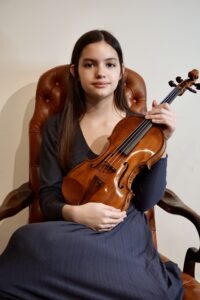
Ava Pakiam is a thirteen-year-old violinist studying at the Pre-College of the San Francisco Conservatory of Music. She was admitted into the Pre-College program at age seven and is currently a student of Simon James.
Ava made her solo debut at eight years old in California performing the Mozart Violin Concerto No. 2 with the Fremont Symphony Orchestra. Later that summer she performed Vivaldi’s Winter Concerto with the Sempre Musik Orchestra and New York Sinfonietta in Boston and New York City, making her solo debut at Carnegie Hall.
Ava has had the privilege of performing in masterclasses for violinists Nathan Cole, Noah Geller, Ariel Horowitz, James Ehnes, Vadim Gluzman, and Hilary Hahn. In the fall of 2021, Ava competed in the Seattle Young Artists Auditions and was awarded the opportunity to perform as soloist with the Seattle Symphony on a 2021–22 season concert playing the Saint-Saëns Introduction and Rondo capriccioso. At age twelve, as a participant in the Sounding Point Academy at the Colburn School in Los Angeles, Ava had the honor of being the youngest student chosen to perform in an evening recital that was streamed live by The Violin Channel.
Ava’s recent performances have included Sarasate’s Ziguenerweisen and William Grant Still’s Summerland with the Lynchburg Symphony Orchestra as well as Prokofiev’s Violin Concerto No. 2 with the Prometheus Symphony Orchestra. Her season schedule also includes the Barber Violin Concerto with the Olympia Symphony Orchestra and the Mendelssohn Violin Concerto with the Washington Sinfonietta. She is also appearing in multiple recitals in the Washington, DC, area and in San Francisco with pianist Cole Anderson.
Ava is incredibly grateful to be playing an 1874 J. B. Vuillaume violin, currently on loan from Strumenti. Patron investors can help keep this violin in Ava’s hands by investing in it online at strumenti.com. Ava’s new partnership with Strumenti was featured in Strings magazine, August edition. In addition to music, Ava loves art, baking, and creative writing.